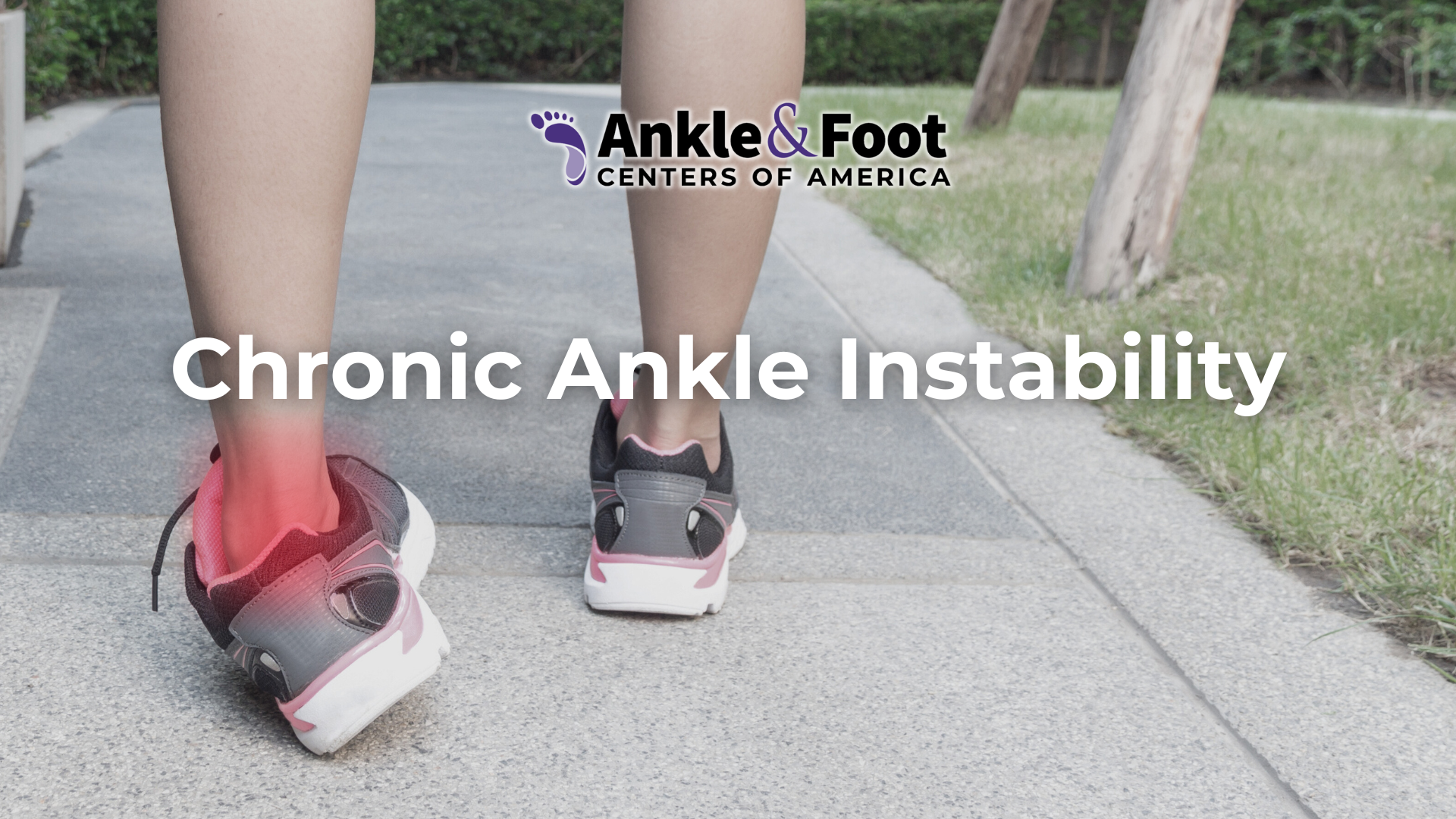Table of Contents
Introduction
Chronic ankle instability is a condition that occurs when the outer side of the ankle frequently gives way. This often happens after repeated ankle sprains or ligament injuries that haven’t healed properly. Over time, the ankle becomes weaker, leading to ongoing instability and difficulty walking on uneven surfaces. For those affected, daily activities such as walking, running, or playing sports can become challenging and painful.
In this article, we’ll explore the symptoms, causes, and treatment options for chronic ankle instability. You will learn how to regain stability and prevent further injury. Whether you’re seeking non-surgical solutions or wondering if chronic ankle instability surgery is right for you, we’ve got you covered.
Chronic Ankle Instability Symptoms
 If you’ve experienced repeated ankle sprains or injuries, you might be familiar with the ongoing discomfort and instability that follow. Chronic ankle instability symptoms often include:
If you’ve experienced repeated ankle sprains or injuries, you might be familiar with the ongoing discomfort and instability that follow. Chronic ankle instability symptoms often include:
- Frequent ankle “giving way”: This happens during walking, physical activities, or even while standing, causing the ankle to feel unstable.
- Swelling and tenderness: The ankle may swell after activity or feel tender, especially after previous injuries.
- Persistent pain: Pain continues even after the sprain heals, causing weakness and difficulty with normal activities.
- Difficulty with balance: Chronic ankle instability often results in poor balance, making it harder to move quickly or play sports.
Causes of Chronic Ankle Instability
- Ligament Damage: When you sprain your ankle severely, ligaments can tear completely, weakening the joint. Without proper recovery, these ligaments lose their strength and elasticity, making your ankle more vulnerable to future injuries.
- Improper Rehabilitation: Skipping or cutting short your rehab after an ankle injury sets the stage for chronic instability. Physical therapy strengthens the muscles around your ankle, improves balance, and restores range of motion. Rushing back to activities too soon leaves your ankle weak and more prone to future sprains.
- Muscle Weakness: Strong muscles are key to supporting your ankle. When the muscles, especially the peroneal muscles, become weak due to injury or neglect, they fail to stabilize the joint. As a result, your ankle is more likely to give out during physical activities.
- Joint Laxity: Some people naturally have loose ligaments, which makes them more prone to ankle sprains. If you have joint laxity, your ligaments don’t provide the support needed to stabilize your ankle. Over time, this flexibility can lead to chronic instability, especially after repeated injuries.
- Improper Footwear: Wearing the wrong shoes, such as high heels or worn-out footwear, puts extra pressure on your ankle and increases the risk of sprains. Choosing supportive shoes with cushioning is crucial, especially if you’ve had ankle issues in the past.
By identifying and addressing these common causes, you can take steps to prevent further injury and improve ankle stability.
How to Fix Chronic Ankle Instability
 If left untreated, chronic ankle instability can lead to long-term mobility issues. However, several methods can effectively manage and improve this condition, depending on its severity. Below are key approaches to treating chronic ankle instability.
If left untreated, chronic ankle instability can lead to long-term mobility issues. However, several methods can effectively manage and improve this condition, depending on its severity. Below are key approaches to treating chronic ankle instability.
- Physical Therapy: First and foremost, physical therapy is one of the best non-surgical treatments available. It helps strengthen the muscles around the ankle, improve balance, and restore the range of motion. This approach typically includes:
- Balance Training: To begin with, balance exercises help retrain the ankle to stabilize itself, significantly reducing the risk of future sprains.
- Strengthening Exercises: Additionally, specific exercises focus on building the muscles, particularly the peroneal muscles, which provide crucial support to the ankle joint.
- Range of Motion Exercises: Finally, stretching and mobility exercises maintain ankle flexibility, which prevents stiffness and enhances overall movement.
- Bracing and Support: Ankle braces provide external support, limiting excessive movement during activities. Different braces are available depending on the severity of the instability. Bracing is often combined with physical therapy.
- Activity Modification: Avoid activities that strain the ankle, such as high-impact sports, uneven surfaces, or extended standing, especially during early treatment stages.
- Footwear Adjustments: Supportive shoes with ankle stability, arch support, and cushioning reduce ankle strain. Custom orthotics can also improve alignment and reduce sprain risk.
- Surgery: However, if non-surgical treatments fail, chronic ankle instability surgery might be necessary to repair or reconstruct damaged ligaments.
- Rest and Recovery: In more severe cases, rest allows the ankle to heal fully. This often involves weeks of non-weight-bearing activities, followed by a gradual recovery.
Chronic Ankle Instability Surgery
 When non-surgical treatments fail to improve chronic ankle instability, surgery may be necessary to restore stability and prevent further ankle sprains. The goal of surgery is to repair or reconstruct the damaged ligaments that no longer provide adequate support to the joint.
When non-surgical treatments fail to improve chronic ankle instability, surgery may be necessary to restore stability and prevent further ankle sprains. The goal of surgery is to repair or reconstruct the damaged ligaments that no longer provide adequate support to the joint.
- Ligament Repair (Broström Procedure): This procedure involves tightening and repairing the damaged ligaments that stabilize the ankle. The surgeon shortens and secures the stretched ligaments to restore their function. This is the most commonly performed surgery for ankle instability.
- Ligament Reconstruction: For more severe cases, where the ligaments are too damaged to be repaired, the surgeon may perform a ligament reconstruction. This involves using a tendon graft from another part of the body or a donor to replace the damaged ligament.
- Arthroscopy: In some cases, arthroscopic surgery is performed to remove scar tissue, loose cartilage, or other debris inside the joint that may be contributing to instability. This is often done in conjunction with ligament repair.
Recovery Process
- Initial Recovery: The ankle is immobilized in a cast or boot for 2-4 weeks, and weight-bearing is limited.
- Physical Therapy: After the initial healing, physical therapy is essential to restore strength, balance, and range of motion.
- Full Recovery: Most patients can resume normal activities within 3-6 months, though full recovery may take longer for athletes or those returning to high-impact activities.

FAQ: Chronic Ankle Instability
Q: Can Chronic Ankle Instability Be Cured?
A: While not everyone experiences a full “cure,” most people can manage chronic ankle instability through physical therapy or surgery, significantly reducing symptoms.
Q: Is Chronic Ankle Instability Permanent?
A: It doesn’t have to be permanent. With proper treatment, including physical therapy or surgery, many people regain stability and avoid long-term issues.
Q: Does Chronic Ankle Instability Require Surgery?
A: Not always. Surgery is typically only necessary if non-surgical treatments like physical therapy and bracing don’t improve the condition.
Q: What Are Two Danger Signs of Ankle Ligament Instability?
A: Frequent “giving way” of the ankle and persistent swelling or pain are two major signs of ankle ligament instability.
Q: What to Do for Chronic Ankle Instability?
A: See a podiatrist for an evaluation. Treatments include physical therapy, bracing, activity modification, proper footwear, and surgery for severe cases.
Conclusion
Chronic ankle instability can significantly affect your daily activities and overall quality of life; however, with the right treatment, it’s manageable. By seeking early diagnosis and taking proactive steps—such as seeing a podiatrist, engaging in physical therapy, and using proper support—you can regain ankle strength and stability. If conservative treatments don’t provide relief, surgical options can offer long-term solutions.
So, if you’re experiencing persistent ankle issues, don’t wait—contact the experts at Ankle & Foot Centers of America. Our experienced podiatrists specialize in treating chronic ankle instability and will guide you through a personalized treatment plan. Take action now and get back to moving confidently—schedule your appointment today!






